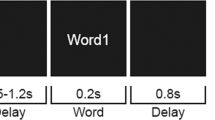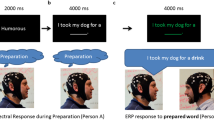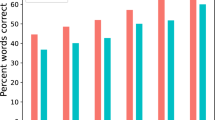Abstract
Two different groups of normal college students were formed: One (the alpha group) received 10-Hz audiovisual (AV) stimulation for 8 minutes, and the other (beta) group received 22-Hz AV stimulation for 8 minutes. EEG power in the alpha (8-13 Hz) and beta (13-30 Hz) bands was FFT-extracted before, during, and for 24 minutes after stimulation. It was found that baseline (prestimulation) alpha and beta power predict the effects of stimulation, leading to individual differences in responsivity. High-baseline alpha participants showed either no entrainment or relatively prolonged entrainment with alpha stimulation. Low-baseline participants showed transient entrainment. Baseline alpha also predicted the direction of change in alpha with beta stimulation. Baseline beta and alpha predicted beta band response to beta stimulation, which was transient enhancement in some participants, inhibition in others. Some participants showed relatively prolonged beta enhancement with beta stimulation.
Similar content being viewed by others
REFERENCES
Adrian, E. D., & Matthews, B. H. C. (1934). Berger rhythm: Potential changes from occipital lobes in man. Brain, 57, 355–385.
Brauchli, P., Michel, C. M., & Zeier, H. (1995). Electrocortical, autonomic, and subjective responses to rhythmic audiovisual stimulation. International Journal of Psychophysiology, 19, 53–66.
Carter, J. L., & Russell, H. L. (1993). A pilot investigation of auditory and visual entrainment of brain wave activity in learning disabled boys. Texas Researcher, 4, 65–75.
Lubar, J. F. (1985). Changing EEG activity through biofeedback. Theory into Practice, 24, 106–111.
Montgornery, D. D., Ashley, E., Burns, W. J., & Russell, H. L. (1994). Clinical outcome of a single case study of EEG entrainment for closed head injury. Proceedings of the Association for Applied Psychophysiology and Biofeedback, 25, 82–83.
Morse, D. R. (1993). Brain wave synchronizers. Stress Medicine, 9, 111–126.
Pigeau, R. A., & Frame, A. M. (1992). Steady state visual evoked responses in high and low alpha participants. Electroencephalography and Clinical Neurophysiology, 84, 101–109.
Regan, D. (1972). Evoked potentials. London: Chapman and Hall.
Rozelle, G. R., & Budzynski, T. H. (1995). Neurotherapy for stroke rehabilitation: A single case study. Biofeedback and Self-Regulation, 20, 211–228.
Russell, H. L., Carter, J. L., Bell, S., & Bush, R. (1995). Quantitative changes in brain functioning following auditory and photic stimulation. Unpublished manuscript (under review).
Simon, R. H., Zimmerman, A. W., Tasman, A., & Hale, M. S. (1982). Spectral analysis of photic stimulation in migraine. Electroencephalography and Clinical Neurophysiology, 53, 270–276.
Sterman, M. B. (1984). The role of the sensorimotor rhythmic activity in the etiology and treatment of generalized motor seizures. In T. Elbert, B. Rockstroh, W. Lutzenberger, & N. Birbaumer (Eds.), Self-regulation of the brain and behavior (pp. 95–106). New York: Springer-Verlag.
Sterman, M. B., Mann, C. A., Kaiser, D. A., & Suyenoba, B. Y. (1994). Multiband and topographic EEG analysis of a simulated visuomotor aviation task. International Journal of Psychophysiology, 16, 49–56.
Walter, V. J., & Walter, W. G. (1949). The central effects of rhythmic sensory stimulation. Electroencephalography and Clinical Neurophysiology, 1, 57–86.
Author information
Authors and Affiliations
Rights and permissions
About this article
Cite this article
Rosenfeld, J.P., Reinhart, A.M. & Srivastava, S. The Effects of Alpha (10-Hz) and Beta (22-Hz) “Entrainment” Stimulation on the Alpha and Beta EEG Bands: Individual Differences Are Critical to Prediction of Effects. Appl Psychophysiol Biofeedback 22, 3–20 (1997). https://doi.org/10.1023/A:1026233624772
Issue Date:
DOI: https://doi.org/10.1023/A:1026233624772




